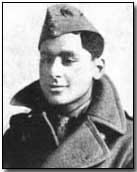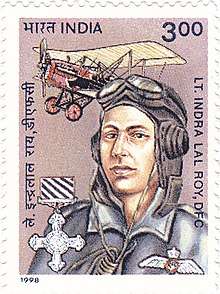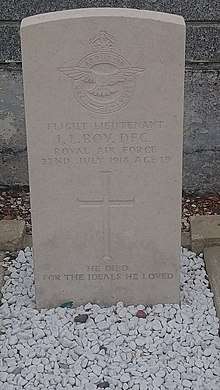Indra Lal Roy
Indra Lal Roy (Bengali: ইন্দ্রলাল রায়), DFC (2 December 1898 – 22 July 1918) is the sole Indian World War I flying ace.[1][2] He is designated as First Indian Fighter Aircraft Pilot. While serving in the Royal Flying Corps and its successor, the Royal Air Force, he claimed ten aerial victories; five aircraft destroyed (one shared), and five 'down out of control' (one shared) in just over 170 hours flying time.[3]
Indra Lal Roy | |
|---|---|
 Indra Lal Roy in his Royal Flying Corps uniform. | |
| Native name | ইন্দ্রলাল রায় |
| Nickname(s) | "Laddie" |
| Born | 2 December 1898 Calcutta, British India |
| Died | 22 July 1918 (aged 19) Carvin, France |
| Buried | Estevelles Communal Cemetery, Pas-de-Calais, France (50°28′32″N 2°54′02″E) |
| Allegiance | United Kingdom |
| Service/ | British Indian Army Royal Flying Corps |
| Years of service | 1917–1918 |
| Rank | Lieutenant |
| Unit | No. 56 Squadron RFC No. 40 Squadron RAF |
| Battles/wars | World War I • Western Front |
| Awards | Distinguished Flying Cross |
| Relations | Paresh Lal Roy (brother) |
Family background
The second son of Piera Lal Roy and Lolita Roy, he was born in Calcutta, where his father was a barrister and Director of Public Prosecutions. He was nicknamed "Laddie".[4] Roy came from a highly qualified and distinguished family. The Roy family is a Bengali family originally from the Barisal district in present-day Bangladesh. Prior to India's partition, the Roy family was a prominent Zamindar family of East Bengal. The Roy family estate is known as Lakhutia (note: there are several variations of the spelling of this word, including ‘Lakutia’ and ‘Lakhotia’). The Lakhutia Zamindar estate was founded by Roop Chandra Roy in the late 17th century.[5][6] His older brother, Paresh Lal Roy (1893–1979), served in the 1st Battalion, Honourable Artillery Company, and later became known as the "father of Indian boxing."[2] His maternal grandfather, Dr. Surya Kumar Goodeve Chakraborty, was one of the first Indian doctors to be trained in Western medicine.[2] His nephew, Subroto Mukerjee (1911–1960), served as a fighter pilot in World War II, and later became the first Indian Chief of Air Staff of the Indian Air Force.[2][7]
First World War
When the First World War broke out, Roy was attending St Paul's School, Hammersmith in London, England. Initially rejected by the Royal Flying Corps on the grounds of poor eyesight, Roy paid for a second opinion from a leading eye specialist, and the decision was overturned. Five months after turning 18, on 4 April 1917[8] he joined the RFC, and was commissioned as a second lieutenant on 5 July.[9] After training and gunnery practice at Vendôme and Turnberry, he joined No. 56 Squadron on 30 October. Roy was part of "A" Flight, commanded by Captain Richard Maybery.[10]
Two months later, Roy was injured after he crash-landed his S.E.5a fighter on 6 December. While recovering, Roy made numerous sketches of aircraft — many of which survive. In May he returned to duty as an equipment officer and within a few weeks was passed as medically fit to fly.[11] He was transferred to Captain George McElroy's flight in No. 40 Squadron in June 1918.[10]
On his return to active service, Roy achieved ten victories (two shared) in thirteen days. His first was a Hannover over Drocourt on 6 July. This was followed by three victories in the space of four hours on 8 July (two Hannover Cs and a Fokker D.VII); two on 13 July (a Hannover C and a Pfalz D.III); two on 15 July (two Fokker D.VIIs); and one on 18 July (a DFW C.V). Roy's final victory came the following day when he shot down a Hannover C over Cagnicourt.[12] He is believed to be the first and only Indian flying ace of the First World War.[13]
Roy was killed over Carvin on 22 July 1918 in a dog fight against the Fokker D.VIIs of Jagdstaffel 29.[10] He is buried at Estevelles Communal Cemetery, Pas-de-Calais, France.[14]
List of aerial victories
| No. | Date/Time | Aircraft/ Serial No. |
Opponent | Result | Location | Notes |
|---|---|---|---|---|---|---|
| 1 | 6 July 1918 @ 0545 |
S.E.5a (B180) | Hannover C | Out of control | Drocourt | |
| 2 | 8 July 1918 @ 0645 |
S.E.5a (B180) | Hannover C | Out of control | Drocourt | |
| 3 | 8 July 1918 @ 0925 |
S.E.5a (B180) | Hannover C | Out of control | East of Monchy | Shared with Captain George McElroy and Lieutenant Gilbert Strange. |
| 4 | 8 July 1918 @ 1025 |
S.E.5a (B180) | Fokker D.VII | Out of control | South-east of Douai | |
| 5 | 13 July 1918 @ 0645 |
S.E.5a (B180) | Hannover C | Destroyed | West of Estaires | Shared with Captain George McElroy, and Lieutenants Gilbert Strange & F. H. Knobel. |
| 6 | 13 July 1918 @ 2005 |
S.E.5a (B180) | Pfalz D.III | Destroyed | Vitry — Brebières | |
| 7 | 15 July 1918 @ 2005 |
S.E.5a (B180) | Fokker D.VII | Destroyed | Hulloch | |
| 8 | Fokker D.VII | Out of control | ||||
| 9 | 18 July 1918 @ 2040 |
S.E.5a (B180) | DFW C.V | Destroyed | South-east of Arras | |
| 10 | 19 July 1918 @ 1025 |
S.E.5a (B180) | Hannover C | Destroyed | Cagnicourt | |
Awards and honours


Roy was posthumously awarded the Distinguished Flying Cross (DFC)[4] in September 1918 for his actions during the period of 6–19 July 1918. He was the first Indian to receive the DFC.[15] His citation read:

- Lieutenant Indra Lal Roy.
- "A very gallant and determined officer, who in thirteen days accounted for nine enemy machines. In these several engagements he has displayed remarkable skill and daring, on more than one occasion accounting for two machines in one patrol. (20 September 1918)[16]
In December 1998, to mark the 100th anniversary of his birth, the Indian postal service issued a commemorative stamp in his honour.[4]
References
- Sharma, Manimugdha S. (8 October 2014). "Indians who lorded over European skies in WWI". The Times of India. Retrieved 8 October 2015.
- "Indra Lal Roy 97th death anniversary: Some unknown facts you must know about the flying ace". India Today. 22 July 2015. Retrieved 8 October 2015.
- Shores, Christopher F.; Franks, Norman; Guest, Russell F. (1990). Above the Trenches: a Complete Record of the Fighter Aces and Units of the British Empire Air Forces 1915–1920. London, UK: Grub Street. p. 328. ISBN 978-0-948817-19-9.CS1 maint: ref=harv (link)
- Dutt, J. K. (18 January 2009). "The young air warrior". The Telegraph. Kolkata. Retrieved 29 June 2015.
- Lonely Traveler, Barisal: Lakhutia Jomidar Bari, 5 January 2015, accessed on 30 July 2017
- ‘Barisal: Durga Sagar and Lakutia Zaminder Bari’ video, in The Daily Star, 22 October 2016, accessed on 30 July 2017.
- "The Roy brothers: fighting for King and Emperor". Great War London. 9 October 2013. Retrieved 1 January 2016.
- "He reached for the skies". The Telegraph. Kolkata. 8 November 2015. Retrieved 1 January 2016.
- "No. 30203". The London Gazette (Supplement). 24 July 1917. pp. 7607–7608.
- "Who's Who – Indra Lal Roy". First World War.com. 2013. Retrieved 1 January 2016.
- "Personals: Casualties". Flight. X (508): 1005. 5 September 1918. Retrieved 1 January 2016.
- "Indra Lal Roy". The Aerodrome. 2016. Retrieved 1 January 2016.
- Lawson, Alastair (22 December 2015). "Three generations united by the hell of war". BBC News. Retrieved 22 December 2015.
- "Casualty Details: Roy, Indrulal L." Commonwealth War Graves Commission. 2016. Retrieved 1 January 2016.
- "Officer's record: Indra Lal Roy (RFC and RAF)". The National Archives. Retrieved 8 October 2015.
- "No. 30913". The London Gazette (Supplement). 20 September 1918. p. 11254.
Further reading
- Basu, Shrabani (2015). For King and Another Country: Indian Soldiers on the Western Front. New Delhi: Bloomsbury India.
External links
| Wikimedia Commons has media related to Indra Lal Roy. |
- Detailed story of Indra Lal Roy
- "Indra Lal Roy". First World War.com. Retrieved 9 September 2005.